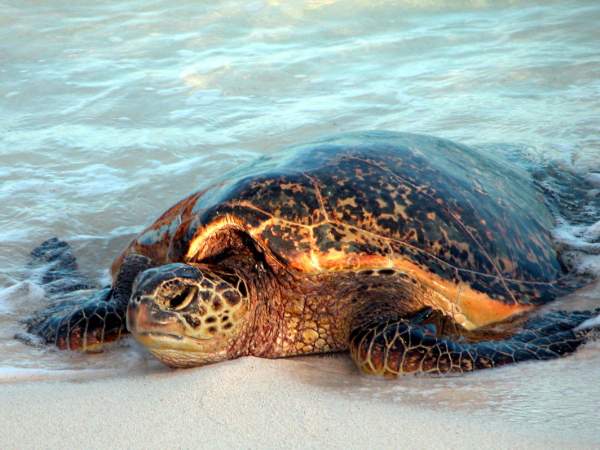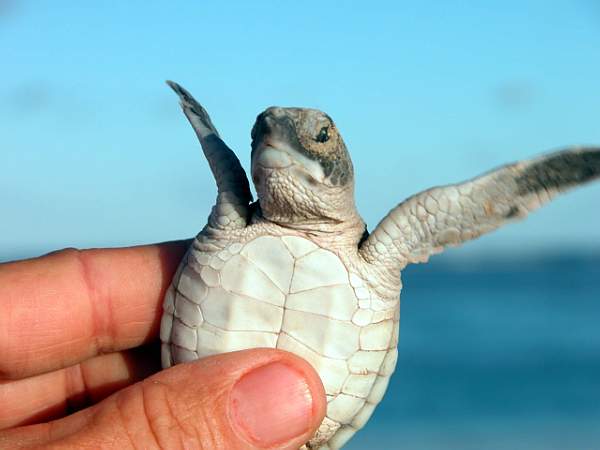Published in the Ocean Watch column, Honolulu Star-Advertiser © Susan Scott
August 2, 2010
A few years ago, while I was working as a volunteer turtle guardian on the North Shore beach Laniakea, an adult sea turtle appeared in the shorebreak. Several visitors and I watched the turtle use the waves to help her get up the beach. She’d rest in the wet sand, and then, when a breaker rolled in and lifted her bulk, she’d dig in her flippers and heave herself a step forward. It took the turtle about 10 of these labored shoves to get her 200-pound (or so) body high and dry. Then she closed her eyes and went to sleep.

I ran a scanner over the napping turtle’s rear flipper, and it flashed the number of a PIT tag, similar to the ones veterinarians use for our cats and dogs. After recording the number, I laid a red rope around the resting animal and placed a few signs to remind admirers to give the turtle space (stay five to six feet away on land and in the water).
Finished with my tasks, I turned to a young woman who’d been standing there the whole time, staring at the turtle. Tears filled her eyes.
“I’ve always loved sea turtles, but I’m from Canada and I thought I’d never see one,” she said. “This is a dream come true.”
We both gazed at the turtle’s brown-and-gold shell, wet and glistening in the morning sun. Her streamlined flippers rested on the sand, and her round bulging eyes were closed in peaceful slumber.
“She’s so beautiful,” the visitor whispered. “She’s like an angel from the sea.”
That moving experience was vivid in my mind last weekend as I bicycled and snorkeled along Oahu’s North Shore. If turtles are angels, I kept thinking, then Hawaii is heaven.
Laniakea is the North Shore’s famous turtle beach, where, since 1999, about 24 green sea turtles have regularly emerged from the water to rest on the sand. This beach-basking behavior is unique to Hawaii’s green turtles, so named for the color of their fat. Nowhere else in the world can you walk on a beach littered with sleeping sea turtles.
People come by the droves to visit these remarkable reptiles, reasonably so. To help educate turtle fans and protect the turtles, about 60 volunteers of the nonprofit organization Malama na Honu take turns monitoring the site.
When I bicycled there last week (as a visitor, not guardian), one large turtle slept on the beach while her colleagues ate seaweed just outside the shorebreak. I knew this because both at Laniakea, and later at a Waialua beach, I could see dozens of turtle heads popping up for breaths of air, and turtle rears tipped up as the animals grazed.
After counting 10 in one small area, I donned mask and snorkel and jumped into the water. A large female swam toward me head-on and slowly, serenely veered off. A moment later she surprised me by approaching from behind and swimming close to my side. For one extraordinary moment, we looked directly into each other’s eyes. The contact I felt with that wild animal moved me to tears.
The experience reminded me of a magazine piece by David Sedaris I’d saved (The New Yorker, December 2009). When a gigantic (his word) sea turtle swam to him and looked him in the eye in Maui waters, he wrote, “That, to me, was worth the entire trip, worth my entire life, practically. For to witness majesty, to find yourself literally touched by it — isn’t that what we’ve all been waiting for?”
 Majesty in miniature.
Majesty in miniature.
It is. And to think that we Hawaii residents can have it any time we want. All we have to do is stand on the beach or stick our faces in the water, and majesty comes to us.
For information about being a guardian of Hawaii’s sea angels, see www.malamanahonu.org.
